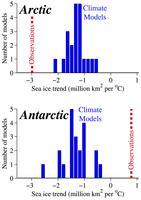 The sea ice covering the high-latitude
oceans around both poles has changed in enigmatic ways during recent decades.
In the Arctic, the ice cover has been rapidly retreating. In the Antarctic, by
contrast, satellite observations indicate that the sea ice cover has been
expanding, with an annual-mean rate 1/3 as fast as the Arctic sea ice retreat.
These changes in both hemispheres disagree sharply with expectations based on
comprehensive climate models, which consistently simulate too little sea ice
loss in the Arctic and too much sea ice loss in the Antarctic (see graphic).
Furthermore, there are surprisingly strong seasonal differences in the sea ice
changes: the sea ice cover in the Arctic has largely recovered toward its long-term
mean each winter, resulting in a year-to-year sea ice retreat that is far more
pronounced in September than in any other month of the year. In this
presentation, I will discuss work I have been doing toward addressing some of
these enigmatic phenomena. This work involves the use of satellite-derived
observations, simulations from comprehensive climate models, and idealized
physical theories.
The sea ice covering the high-latitude
oceans around both poles has changed in enigmatic ways during recent decades.
In the Arctic, the ice cover has been rapidly retreating. In the Antarctic, by
contrast, satellite observations indicate that the sea ice cover has been
expanding, with an annual-mean rate 1/3 as fast as the Arctic sea ice retreat.
These changes in both hemispheres disagree sharply with expectations based on
comprehensive climate models, which consistently simulate too little sea ice
loss in the Arctic and too much sea ice loss in the Antarctic (see graphic).
Furthermore, there are surprisingly strong seasonal differences in the sea ice
changes: the sea ice cover in the Arctic has largely recovered toward its long-term
mean each winter, resulting in a year-to-year sea ice retreat that is far more
pronounced in September than in any other month of the year. In this
presentation, I will discuss work I have been doing toward addressing some of
these enigmatic phenomena. This work involves the use of satellite-derived
observations, simulations from comprehensive climate models, and idealized
physical theories.

